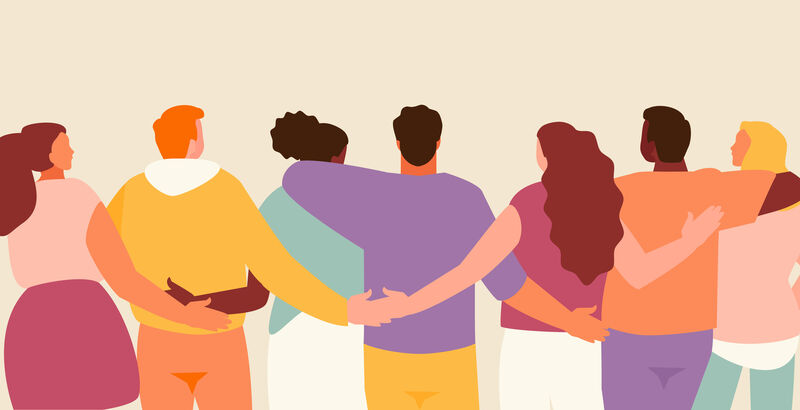
4 Simple Ways to Cultivate Connection and Belonging
Getty/artbesouro
Feeling disconnected from your community and the world around you? Dive into four ways to develop connection and belonging.
“I don’t belong,” admits one of my students, referencing her classmates. “I don’t belong here,” says a middle-aged entrepreneur sitting near me at a retreat. “I don’t belong with them,” confesses a friend speaking about his family.
At both social and professional events, I hear the same sentiment: A perceived lack of welcome, an unease so problematic that many take medication to blunt the gnawing thoughts and feelings that accompany their social anxiety.
I’m astonished by the number of people who possess a well-paying job, a devoted partner, advanced education, good looks, and other qualities that suggest security who are uncomfortable and struggling with acceptance.
How the Brain is Affected by a Lack of Connection and Belonging
If we don’t feel safe, the amygdala (the part of the brain responsible for fleeing or fighting) activates. When activated, the neocortex (the part responsible for creativity and problem solving) pauses to focus on the more primary need of survival.
If the physical, emotional, or psychological threat is severe or ongoing, such as what happens with chronic and acute trauma situations, the amygdala goes into overdrive, which upsets cortisol levels and generates long-term havoc on the immune system, increasing the likelihood of disorders like fibromyalgia.
Politicians and the media continually tell us we’re not safe socially, politically, economically, and environmentally. A vocal portion of the population believes that those who don’t agree with, look like, or behave like them are to be othered. This belief contributes to an increasingly destructive divisiveness.
Othering closes doors to new perceptions, sensory awareness, fresh ideas, and empathy. Many people who choose to “other” their neighbors don’t care how it harms them and don’t recognize how it similarly contributes to their own hurt, fear, or confusion.
Without the feelings of connection and belonging, we lose out on meaningful relationships and the feeling of safety. The gap leads to isolation and loneliness, which can lead us to judge, argue, bully, manipulate, and discount others; a twisted and ineffective way to get our needs met and feel safe.
How to Cultivate Greater Connection and Belonging
In order to counter the effects of disconnection, we must actively participate in connection practices to reconnect with ourselves, our communities, and the world around us.
Connect With Yourself
For the sake of your health, your body must feel like a friendly place. All feelings and sensations—anger and joy, shame and pride, pain and ease—are to be welcomed as temporary truths, passing currents in the inner sensory river that is each of us.
With a mindful focus, we can notice what is taking place within. We investigate emotions and sensations and discover that self-acceptance plays a large role in settling the nervous system and allowing us to rest in the core of our being. We experience our body as a refuge, even a sanctuary.
Connect With Others
Good health and meaningful connection happen when we take genuine interest in and give respect for one another. Genuine interest generates heartful bonds, which make all involved feel welcome and accepted.
Genetically, 98% of our DNA is the same as family, neighbors, and strangers, including those a continent away. The remaining 2% also means that no two people are exactly alike. Such figures show we are significantly more alike than different, each one of us a member of the same family.
Connect to a Place
Location plays a pivotal role in our sense of belonging, be it the ocean or a savanna, a metal office chair or ultra-suede couch. Touching the flaky bark of an oak tree, smelling fresh cut grass, or hearing the tick of a clock or the throaty banjo sound of a frog all bring our surroundings up close.
A healthy sense of place is not crowded with distant, unfeeling, and ignorable objects, but bursting with obvious and subtle phenomena that impact how we feel and think. Sensory connection to surroundings further reinforces a relationship with the self.
Connect to Nature
In connecting to the self, to others, and with a place, we are connecting to who we are fundamentally, to our collective life force, and to nature itself, always in the process of growing and decaying. Connecting establishes relationships and a two-way street of influence.
I am delighted at watching a cardinal land on the dogwood in my backyard, tuned in as the cardinal considers our proximity while determining where to establish its nest. Connecting shows the myriad ways we and others belong and plays a role in the earth’s ecosystem. Connections exist everywhere once we look for them.
A conversation with a student led me to write this article, which led you to read it and, I hope, phone a friend to discuss it, motivating the friend to attend a retreat where they meet an entrepreneur and engage in a conversation of belonging, and so on. A frog needs a pond, a pond needs rain, rain needs atmospheric dust, and so on.
In connecting to nature, we discover continuous variety and mutability of form. There are over 7000 species of frogs worldwide with 28 living in Virginia, my home state. One moment we experience insomnia, followed by hunger, jealousy, joy, curiosity, tiredness, and so forth. Nothing stays the same, not for very long. Everything changes in both seen and unseen ways.
We belong to the ever-changing stream of our thoughts, feelings, and sensations. We belong where we sit or stand or walk or sleep. We belong as an inhabitant of this planet.
Explore the practice of ecosomatics and how it can help us live more connected.









